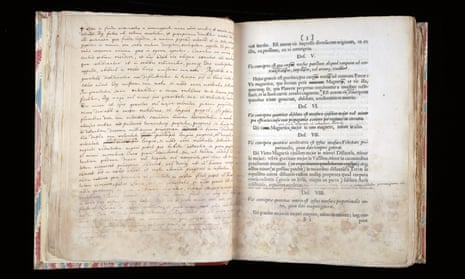A first edition of Sir Isaac Newton’s Principia Mathematica has become the most expensive printed scientific book ever sold at auction after a winning bid of $3.7m (£3m), the auction house Christie’s has announced.
The edition of Newton’s 1687 work, described by Albert Einstein as “perhaps the greatest intellectual stride that it has ever been granted to any man to make”, went for nearly two and a half times its highest estimate.
It was one of the lots in Wednesday night’s sale of fine books and manuscripts auctioned at Christie’s New York office which raised a total of £7.5m.
The continental edition, which was intended to be distributed on the European mainland by Samuel Smith, bears some differences from the British edition. Only about 80 such first editions were thought to have been published, with about 400 in total produced.
Edmund Halley, the astronomer after whom the comet was named, edited the work, having encouraged Newton to produce a single text setting out his ideas. Halley paid for the printing because the Royal Society had run out of funds.
The society retains two copies of the book, including the original manuscript on which the first print run in 1687 was based, which is described as its “greatest treasure”.
Among other ideas, the work sets out Newton’s laws of motion and his law of universal gravitation. The work is a “benchmark in human thought”, Keith Moore, the head of the Royal Society library, has previously said.
“It’s not just the history and development of science; it’s one of the greatest books ever published. It was hugely influential in terms of applying mathematics to basic physical problems.”
He linked the popularity of scientific texts with the number of people who have made their money from technology advancements. “People who have big books these days maybe are the kinds of people who have made their money on the internet or the web ... If you have a few million quid to spend, why wouldn’t you buy a copy of Principia Mathematica?
“If you’ve made your money from a really cool algorithm, you will probably appreciate Newtonian physics.”
According to Christie’s, other sale highlights included nine lots of correspondence to the Marquis de Chastellux, featuring six letters by George Washington and three by Thomas Jefferson. They sold for a total of £900,000.
